Logistics Networks Report - The Business School, Supply Chain
VerifiedAdded on 2022/09/03
|7
|1551
|19
Report
AI Summary
This report delves into the complexities of logistics networks, emphasizing the importance of distribution strategies in satisfying customer needs and the role of smart factories in optimizing production processes. It begins with a literature review exploring the evolution of supply chain management (SCM) principles and the challenges faced within the industry, including price increases, time zone differences, long-term logistics issues, and compliance concerns. The report examines the impact of these issues on supply chain performance and the need for transparency and ethical practices. The report also explores the various factors contributing to the complexity of international business operations. The report concludes by referencing key academic sources that support the findings. This report is a summative assessment for the Supply Chain Planning and Control module (BMT1069) at The Business School.

Running head: Logistics Networks 1
Logistics Networks
Name
Institution
Date
Logistics Networks
Name
Institution
Date
Paraphrase This Document
Need a fresh take? Get an instant paraphrase of this document with our AI Paraphraser

Logistics Networks 2
The distribution strategy has helped determine the optimal supply chain so as to
satisfy customers wants and needs. For a distribution network to be established the cost of
modelling software and service delivery should be considered. A smart factory is an
intelligent device enabling its efficiency, its self-adjustment in real time or near reality and its
self-governing entire production processes by networked development components and an
efficient production system. The intelligent plant provides collaboration, flexibility,
openness, decisiveness and versatility in contrast with a conventional plant and seeks to
tackle the challenges posed by management.
Literature Review
It is not scandalous that a certain supply chain management principle has been
thoroughly investigated based on the relatively recently developed supply chain literature. ⠀
Over the last 18 years, merous papers have been published concerning SCM theory and
practice, but the subject remains under significant growth and discussion (Rajeev, Pati, Padhi,
and Govindan, 2017). Lean supply is the supply chain management system required to
support lean manufacturing. It may aid in several areas (e.g. improving accuracy and saving
costs). The various models in literature concerning the organization of buyer’s models which
use quantity reductions under a deterministic system, were evaluated and categorized by
Mello, Strandhagen and Alfnes, (2015). The latest literature has been examined on the basis
of this conceptualization by the SCM, to figure out the extent to which these fundamental
elements are present in academic research in supply chain management. In the study the
focus was on production companies and the consumer products sector, with a narrow
definition of the supply chain management process. SCM was also considered a developing
field, and in recent times researchers have witnessed a growing interest. Which allows not
only a more thorough evaluation; it also gives an overview of the maturation of the SCM
sector. The goal of the study is also to predict literature discrepancies and future trends of
The distribution strategy has helped determine the optimal supply chain so as to
satisfy customers wants and needs. For a distribution network to be established the cost of
modelling software and service delivery should be considered. A smart factory is an
intelligent device enabling its efficiency, its self-adjustment in real time or near reality and its
self-governing entire production processes by networked development components and an
efficient production system. The intelligent plant provides collaboration, flexibility,
openness, decisiveness and versatility in contrast with a conventional plant and seeks to
tackle the challenges posed by management.
Literature Review
It is not scandalous that a certain supply chain management principle has been
thoroughly investigated based on the relatively recently developed supply chain literature. ⠀
Over the last 18 years, merous papers have been published concerning SCM theory and
practice, but the subject remains under significant growth and discussion (Rajeev, Pati, Padhi,
and Govindan, 2017). Lean supply is the supply chain management system required to
support lean manufacturing. It may aid in several areas (e.g. improving accuracy and saving
costs). The various models in literature concerning the organization of buyer’s models which
use quantity reductions under a deterministic system, were evaluated and categorized by
Mello, Strandhagen and Alfnes, (2015). The latest literature has been examined on the basis
of this conceptualization by the SCM, to figure out the extent to which these fundamental
elements are present in academic research in supply chain management. In the study the
focus was on production companies and the consumer products sector, with a narrow
definition of the supply chain management process. SCM was also considered a developing
field, and in recent times researchers have witnessed a growing interest. Which allows not
only a more thorough evaluation; it also gives an overview of the maturation of the SCM
sector. The goal of the study is also to predict literature discrepancies and future trends of
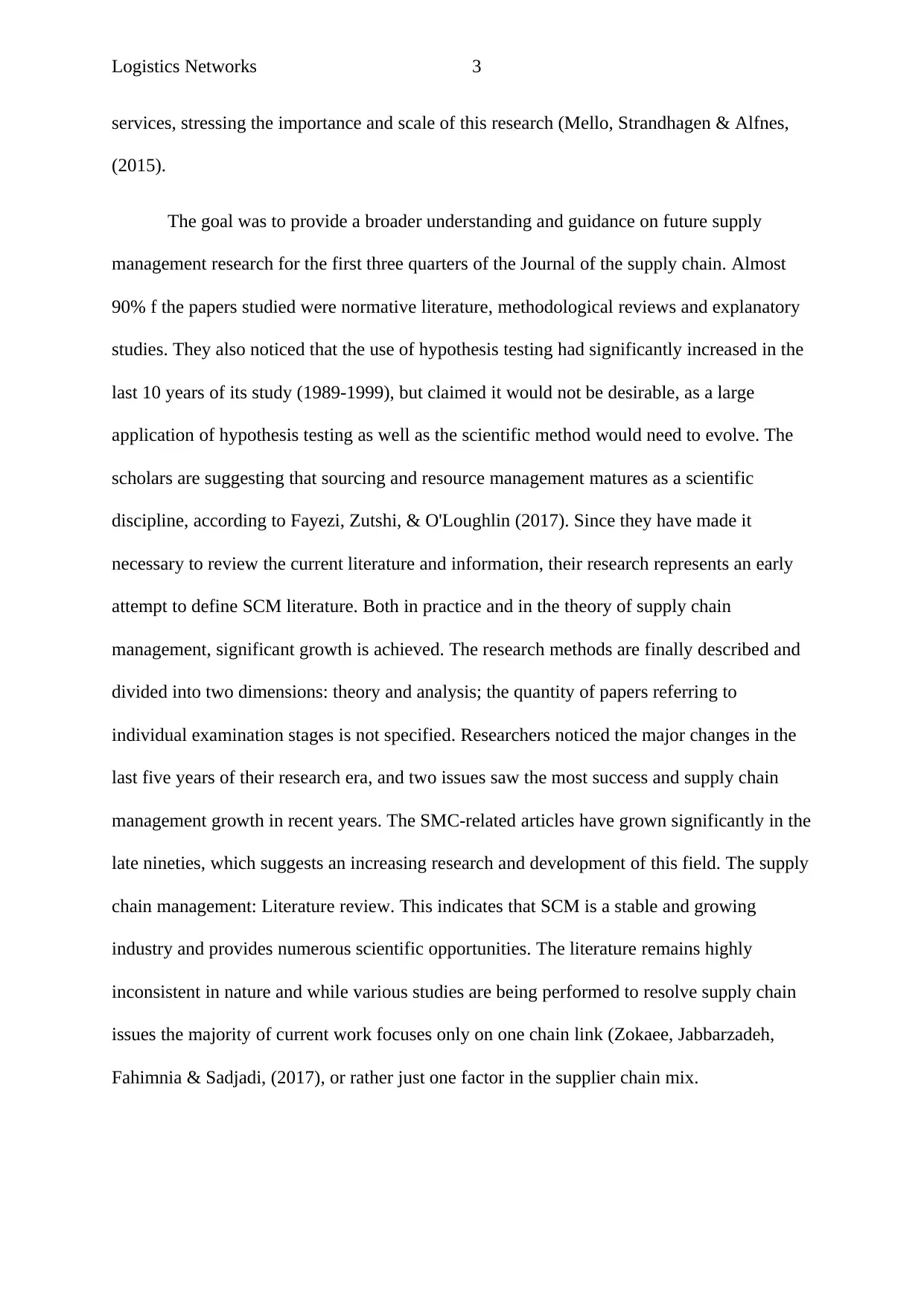
Logistics Networks 3
services, stressing the importance and scale of this research (Mello, Strandhagen & Alfnes,
(2015).
The goal was to provide a broader understanding and guidance on future supply
management research for the first three quarters of the Journal of the supply chain. Almost
90% f the papers studied were normative literature, methodological reviews and explanatory
studies. They also noticed that the use of hypothesis testing had significantly increased in the
last 10 years of its study (1989-1999), but claimed it would not be desirable, as a large
application of hypothesis testing as well as the scientific method would need to evolve. The
scholars are suggesting that sourcing and resource management matures as a scientific
discipline, according to Fayezi, Zutshi, & O'Loughlin (2017). Since they have made it
necessary to review the current literature and information, their research represents an early
attempt to define SCM literature. Both in practice and in the theory of supply chain
management, significant growth is achieved. The research methods are finally described and
divided into two dimensions: theory and analysis; the quantity of papers referring to
individual examination stages is not specified. Researchers noticed the major changes in the
last five years of their research era, and two issues saw the most success and supply chain
management growth in recent years. The SMC-related articles have grown significantly in the
late nineties, which suggests an increasing research and development of this field. The supply
chain management: Literature review. This indicates that SCM is a stable and growing
industry and provides numerous scientific opportunities. The literature remains highly
inconsistent in nature and while various studies are being performed to resolve supply chain
issues the majority of current work focuses only on one chain link (Zokaee, Jabbarzadeh,
Fahimnia & Sadjadi, (2017), or rather just one factor in the supplier chain mix.
services, stressing the importance and scale of this research (Mello, Strandhagen & Alfnes,
(2015).
The goal was to provide a broader understanding and guidance on future supply
management research for the first three quarters of the Journal of the supply chain. Almost
90% f the papers studied were normative literature, methodological reviews and explanatory
studies. They also noticed that the use of hypothesis testing had significantly increased in the
last 10 years of its study (1989-1999), but claimed it would not be desirable, as a large
application of hypothesis testing as well as the scientific method would need to evolve. The
scholars are suggesting that sourcing and resource management matures as a scientific
discipline, according to Fayezi, Zutshi, & O'Loughlin (2017). Since they have made it
necessary to review the current literature and information, their research represents an early
attempt to define SCM literature. Both in practice and in the theory of supply chain
management, significant growth is achieved. The research methods are finally described and
divided into two dimensions: theory and analysis; the quantity of papers referring to
individual examination stages is not specified. Researchers noticed the major changes in the
last five years of their research era, and two issues saw the most success and supply chain
management growth in recent years. The SMC-related articles have grown significantly in the
late nineties, which suggests an increasing research and development of this field. The supply
chain management: Literature review. This indicates that SCM is a stable and growing
industry and provides numerous scientific opportunities. The literature remains highly
inconsistent in nature and while various studies are being performed to resolve supply chain
issues the majority of current work focuses only on one chain link (Zokaee, Jabbarzadeh,
Fahimnia & Sadjadi, (2017), or rather just one factor in the supplier chain mix.
⊘ This is a preview!⊘
Do you want full access?
Subscribe today to unlock all pages.

Trusted by 1+ million students worldwide
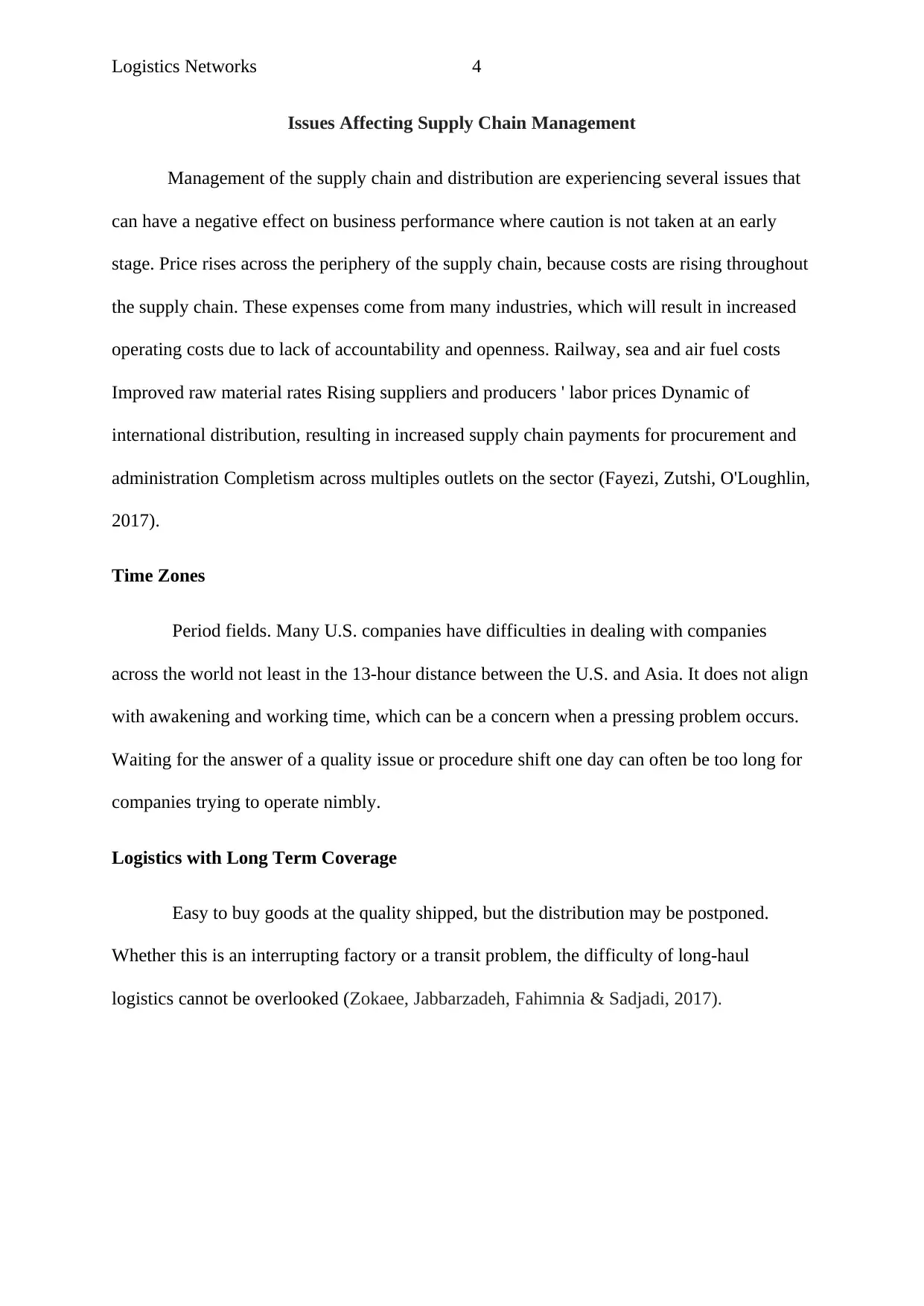
Logistics Networks 4
Issues Affecting Supply Chain Management
Management of the supply chain and distribution are experiencing several issues that
can have a negative effect on business performance where caution is not taken at an early
stage. Price rises across the periphery of the supply chain, because costs are rising throughout
the supply chain. These expenses come from many industries, which will result in increased
operating costs due to lack of accountability and openness. Railway, sea and air fuel costs
Improved raw material rates Rising suppliers and producers ' labor prices Dynamic of
international distribution, resulting in increased supply chain payments for procurement and
administration Completism across multiples outlets on the sector (Fayezi, Zutshi, O'Loughlin,
2017).
Time Zones
Period fields. Many U.S. companies have difficulties in dealing with companies
across the world not least in the 13-hour distance between the U.S. and Asia. It does not align
with awakening and working time, which can be a concern when a pressing problem occurs.
Waiting for the answer of a quality issue or procedure shift one day can often be too long for
companies trying to operate nimbly.
Logistics with Long Term Coverage
Easy to buy goods at the quality shipped, but the distribution may be postponed.
Whether this is an interrupting factory or a transit problem, the difficulty of long-haul
logistics cannot be overlooked (Zokaee, Jabbarzadeh, Fahimnia & Sadjadi, 2017).
Issues Affecting Supply Chain Management
Management of the supply chain and distribution are experiencing several issues that
can have a negative effect on business performance where caution is not taken at an early
stage. Price rises across the periphery of the supply chain, because costs are rising throughout
the supply chain. These expenses come from many industries, which will result in increased
operating costs due to lack of accountability and openness. Railway, sea and air fuel costs
Improved raw material rates Rising suppliers and producers ' labor prices Dynamic of
international distribution, resulting in increased supply chain payments for procurement and
administration Completism across multiples outlets on the sector (Fayezi, Zutshi, O'Loughlin,
2017).
Time Zones
Period fields. Many U.S. companies have difficulties in dealing with companies
across the world not least in the 13-hour distance between the U.S. and Asia. It does not align
with awakening and working time, which can be a concern when a pressing problem occurs.
Waiting for the answer of a quality issue or procedure shift one day can often be too long for
companies trying to operate nimbly.
Logistics with Long Term Coverage
Easy to buy goods at the quality shipped, but the distribution may be postponed.
Whether this is an interrupting factory or a transit problem, the difficulty of long-haul
logistics cannot be overlooked (Zokaee, Jabbarzadeh, Fahimnia & Sadjadi, 2017).
Paraphrase This Document
Need a fresh take? Get an instant paraphrase of this document with our AI Paraphraser
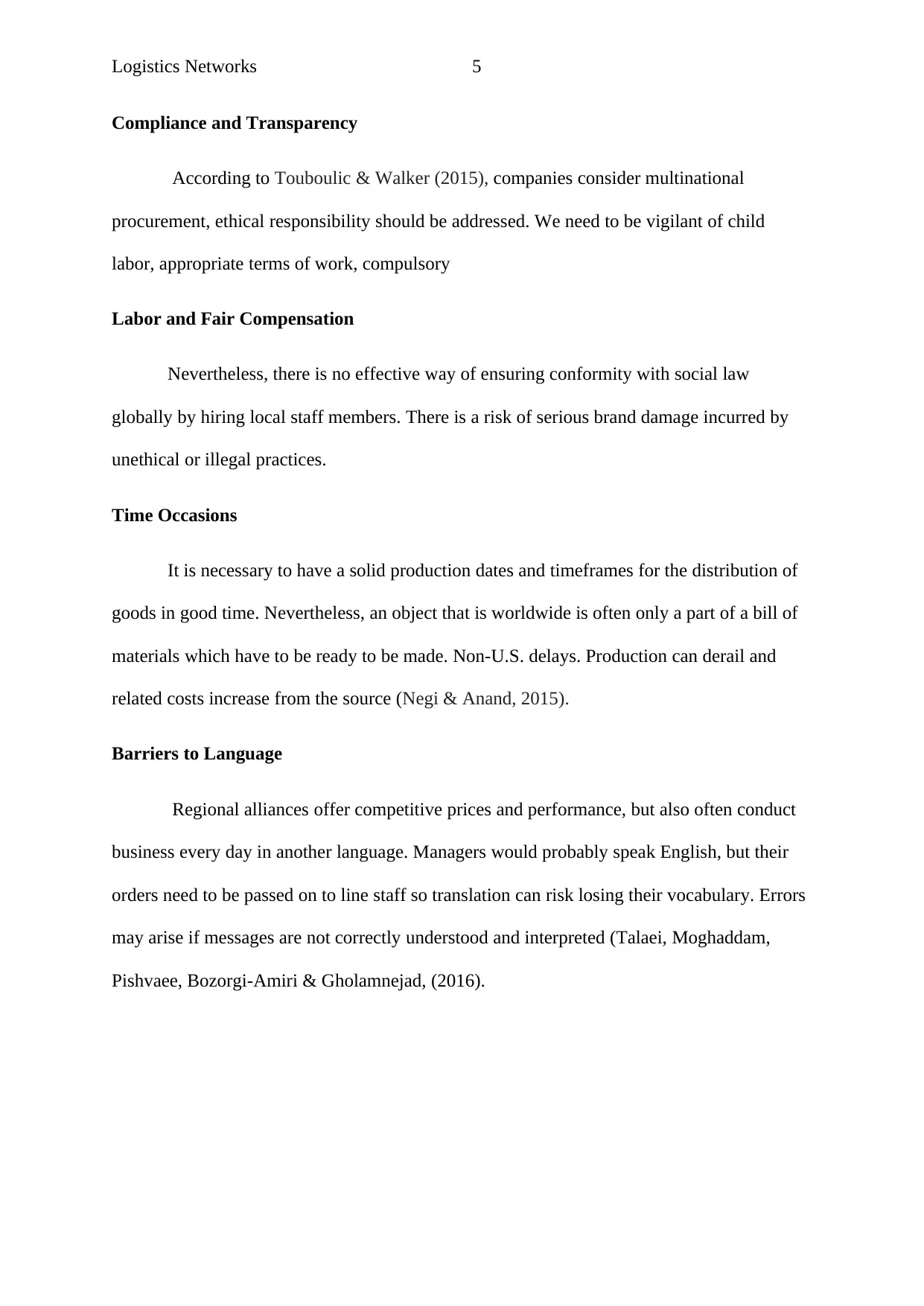
Logistics Networks 5
Compliance and Transparency
According to Touboulic & Walker (2015), companies consider multinational
procurement, ethical responsibility should be addressed. We need to be vigilant of child
labor, appropriate terms of work, compulsory
Labor and Fair Compensation
Nevertheless, there is no effective way of ensuring conformity with social law
globally by hiring local staff members. There is a risk of serious brand damage incurred by
unethical or illegal practices.
Time Occasions
It is necessary to have a solid production dates and timeframes for the distribution of
goods in good time. Nevertheless, an object that is worldwide is often only a part of a bill of
materials which have to be ready to be made. Non-U.S. delays. Production can derail and
related costs increase from the source (Negi & Anand, 2015).
Barriers to Language
Regional alliances offer competitive prices and performance, but also often conduct
business every day in another language. Managers would probably speak English, but their
orders need to be passed on to line staff so translation can risk losing their vocabulary. Errors
may arise if messages are not correctly understood and interpreted (Talaei, Moghaddam,
Pishvaee, Bozorgi-Amiri & Gholamnejad, (2016).
Compliance and Transparency
According to Touboulic & Walker (2015), companies consider multinational
procurement, ethical responsibility should be addressed. We need to be vigilant of child
labor, appropriate terms of work, compulsory
Labor and Fair Compensation
Nevertheless, there is no effective way of ensuring conformity with social law
globally by hiring local staff members. There is a risk of serious brand damage incurred by
unethical or illegal practices.
Time Occasions
It is necessary to have a solid production dates and timeframes for the distribution of
goods in good time. Nevertheless, an object that is worldwide is often only a part of a bill of
materials which have to be ready to be made. Non-U.S. delays. Production can derail and
related costs increase from the source (Negi & Anand, 2015).
Barriers to Language
Regional alliances offer competitive prices and performance, but also often conduct
business every day in another language. Managers would probably speak English, but their
orders need to be passed on to line staff so translation can risk losing their vocabulary. Errors
may arise if messages are not correctly understood and interpreted (Talaei, Moghaddam,
Pishvaee, Bozorgi-Amiri & Gholamnejad, (2016).
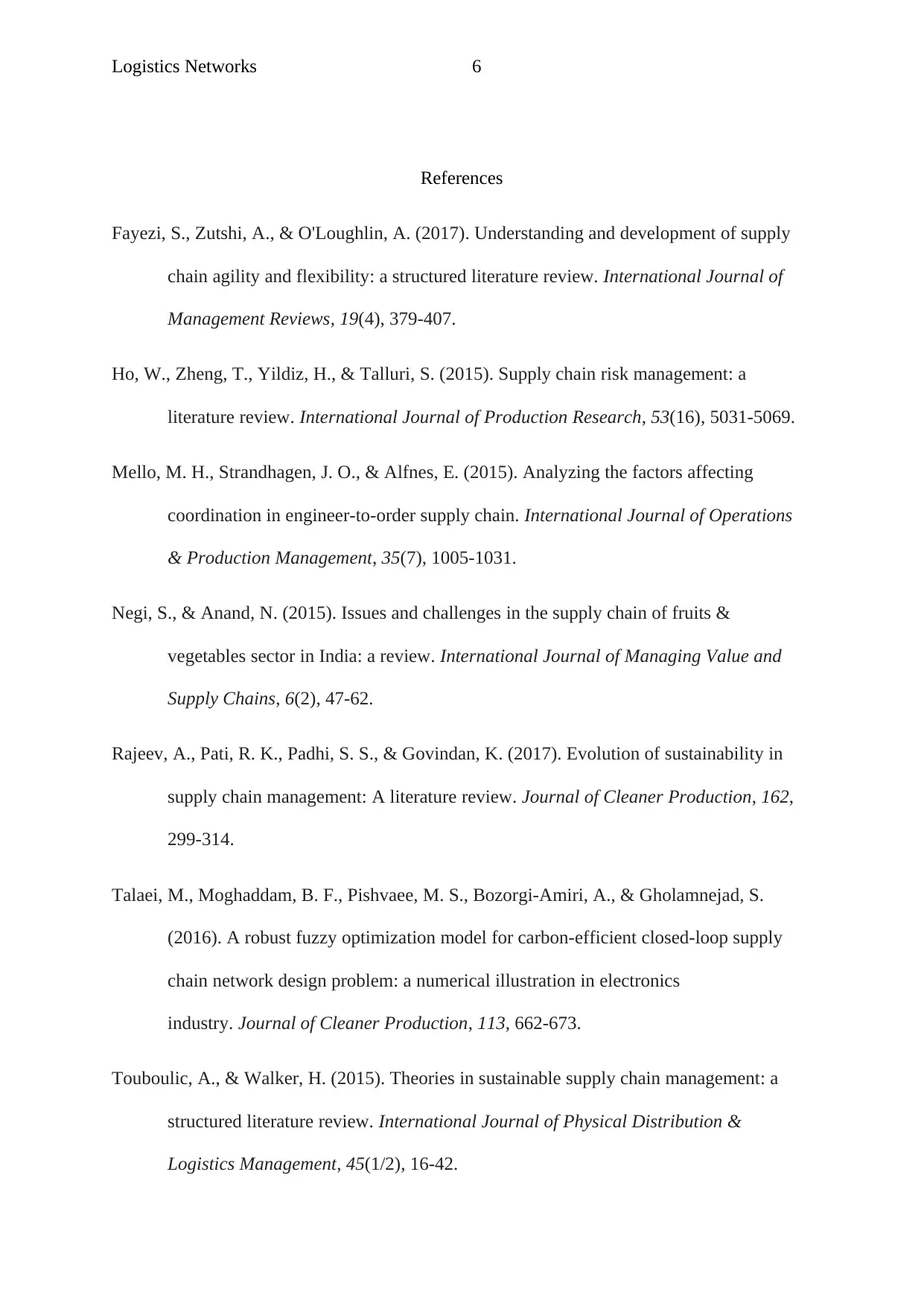
Logistics Networks 6
References
Fayezi, S., Zutshi, A., & O'Loughlin, A. (2017). Understanding and development of supply
chain agility and flexibility: a structured literature review. International Journal of
Management Reviews, 19(4), 379-407.
Ho, W., Zheng, T., Yildiz, H., & Talluri, S. (2015). Supply chain risk management: a
literature review. International Journal of Production Research, 53(16), 5031-5069.
Mello, M. H., Strandhagen, J. O., & Alfnes, E. (2015). Analyzing the factors affecting
coordination in engineer-to-order supply chain. International Journal of Operations
& Production Management, 35(7), 1005-1031.
Negi, S., & Anand, N. (2015). Issues and challenges in the supply chain of fruits &
vegetables sector in India: a review. International Journal of Managing Value and
Supply Chains, 6(2), 47-62.
Rajeev, A., Pati, R. K., Padhi, S. S., & Govindan, K. (2017). Evolution of sustainability in
supply chain management: A literature review. Journal of Cleaner Production, 162,
299-314.
Talaei, M., Moghaddam, B. F., Pishvaee, M. S., Bozorgi-Amiri, A., & Gholamnejad, S.
(2016). A robust fuzzy optimization model for carbon-efficient closed-loop supply
chain network design problem: a numerical illustration in electronics
industry. Journal of Cleaner Production, 113, 662-673.
Touboulic, A., & Walker, H. (2015). Theories in sustainable supply chain management: a
structured literature review. International Journal of Physical Distribution &
Logistics Management, 45(1/2), 16-42.
References
Fayezi, S., Zutshi, A., & O'Loughlin, A. (2017). Understanding and development of supply
chain agility and flexibility: a structured literature review. International Journal of
Management Reviews, 19(4), 379-407.
Ho, W., Zheng, T., Yildiz, H., & Talluri, S. (2015). Supply chain risk management: a
literature review. International Journal of Production Research, 53(16), 5031-5069.
Mello, M. H., Strandhagen, J. O., & Alfnes, E. (2015). Analyzing the factors affecting
coordination in engineer-to-order supply chain. International Journal of Operations
& Production Management, 35(7), 1005-1031.
Negi, S., & Anand, N. (2015). Issues and challenges in the supply chain of fruits &
vegetables sector in India: a review. International Journal of Managing Value and
Supply Chains, 6(2), 47-62.
Rajeev, A., Pati, R. K., Padhi, S. S., & Govindan, K. (2017). Evolution of sustainability in
supply chain management: A literature review. Journal of Cleaner Production, 162,
299-314.
Talaei, M., Moghaddam, B. F., Pishvaee, M. S., Bozorgi-Amiri, A., & Gholamnejad, S.
(2016). A robust fuzzy optimization model for carbon-efficient closed-loop supply
chain network design problem: a numerical illustration in electronics
industry. Journal of Cleaner Production, 113, 662-673.
Touboulic, A., & Walker, H. (2015). Theories in sustainable supply chain management: a
structured literature review. International Journal of Physical Distribution &
Logistics Management, 45(1/2), 16-42.
⊘ This is a preview!⊘
Do you want full access?
Subscribe today to unlock all pages.

Trusted by 1+ million students worldwide
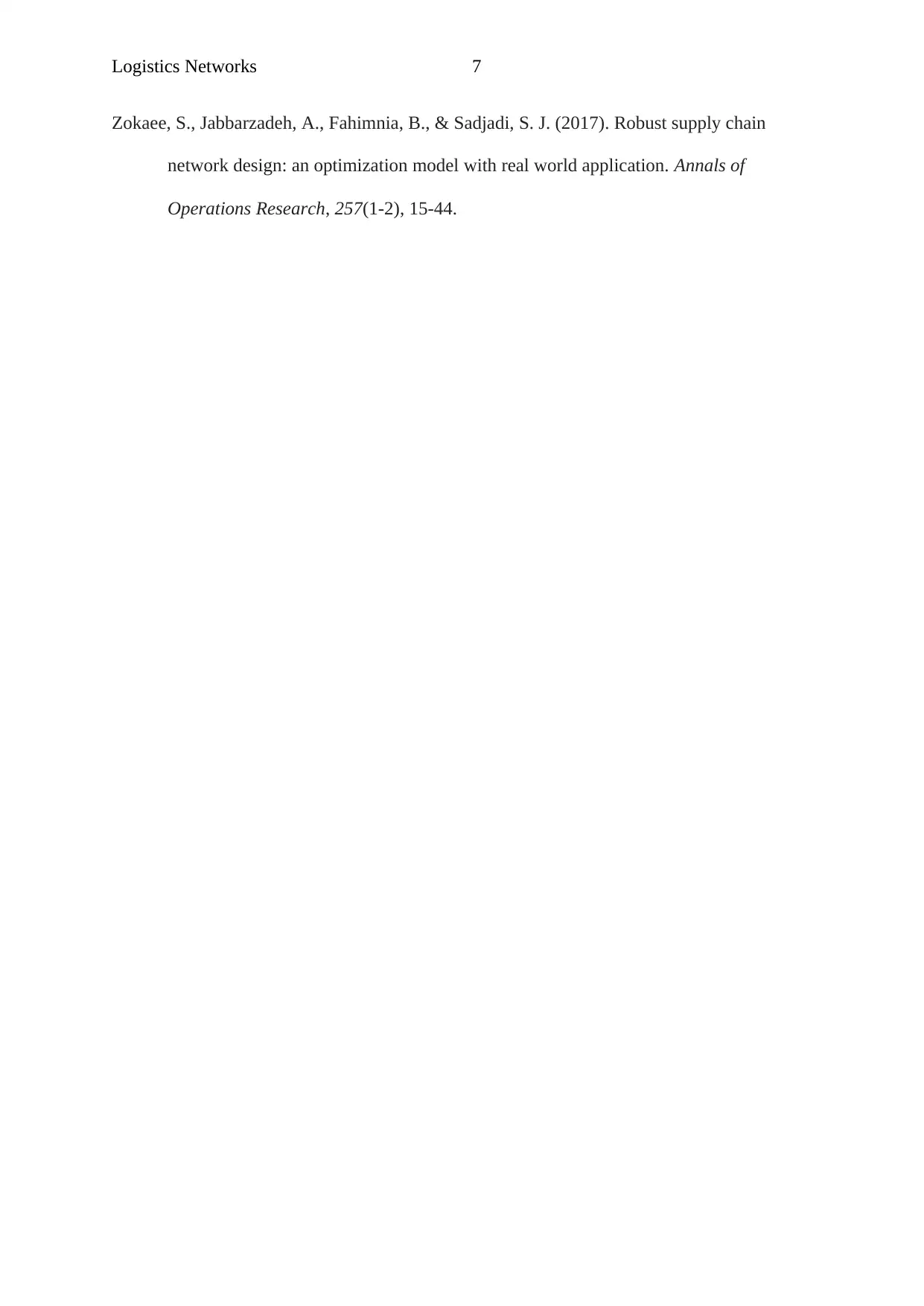
Logistics Networks 7
Zokaee, S., Jabbarzadeh, A., Fahimnia, B., & Sadjadi, S. J. (2017). Robust supply chain
network design: an optimization model with real world application. Annals of
Operations Research, 257(1-2), 15-44.
⠀
Zokaee, S., Jabbarzadeh, A., Fahimnia, B., & Sadjadi, S. J. (2017). Robust supply chain
network design: an optimization model with real world application. Annals of
Operations Research, 257(1-2), 15-44.
⠀
1 out of 7
Related Documents
Your All-in-One AI-Powered Toolkit for Academic Success.
+13062052269
info@desklib.com
Available 24*7 on WhatsApp / Email
![[object Object]](/_next/static/media/star-bottom.7253800d.svg)
Unlock your academic potential
Copyright © 2020–2025 A2Z Services. All Rights Reserved. Developed and managed by ZUCOL.



